Directions for Questions 56 and 57: In each question, there is a table having 3 columns and 4 rows. Based on the table, there are 3 questions. Each question has 4 options (a), (b), (c) and (d), ONLY ONE of these four options is correct.
Two charges of opposite sign and equal magnitude Q = 2.0 C are held 2.0 m apart. And there is a point Pat 4.0 cm from +Q charge. In the given table there are four values each of electric field (Column I), potential difference each of electric field (Column I), potential difference
{:("Column I","Column II", "Column III"),((I) E=1.27 xx 10^(9) V//m,(i) V=1.5 xx 10^(9) V,(J) (##MST_AG_JEE_MA_PHY_V02_C24_E03_061_Q01.png" width="80%">
(3) The combination for minimum electric potential is
(I) (iii) (M)
(II) (ii) (K)
(III) (i) (L)
(IV) (iv} (J)
The correct Answer is:C, D
Topper's Solved these Questions
- ELECTRIC POTENTIALBook:RESNICK AND HALLIDAYChapter:ELECTRIC POTENTIALExercise:(PRACTICE QUESTIONS) Integer Type
Explore 1 Video
- ELECTRIC POTENTIALBook:RESNICK AND HALLIDAYChapter:ELECTRIC POTENTIALExercise:(PRACTICE QUESTIONS) Linked Comprehension
Explore 2 Videos
- ELECTRIC CHARGES AND FIELDSBook:RESNICK AND HALLIDAYChapter:ELECTRIC CHARGES AND FIELDSExercise:Practice Questions (Integer Type )
Explore 3 Videos
- ELECTROMAGNETIC INDUCTIONBook:RESNICK AND HALLIDAYChapter:ELECTROMAGNETIC INDUCTIONExercise:PRACTICE QUESTIONS (Integer Type)
Explore 14 Videos
Similar Questions
In each question, there is a table having 3 columns and 4 rows. Based on the table, there are 3 questions. Each question has 4 options (a), (b), ( c) and (d), ONLY ONE of these four options is correct.

Which object has 480N⋅m as the resulting torque (as a vector)?
View SolutionThe following tables has 3 columns and 4 rows. Based on each table, there are THREE questions. Each question has FOUR options (A), (B), (C), and (D). ONLY ONE of these four options is correct
Q
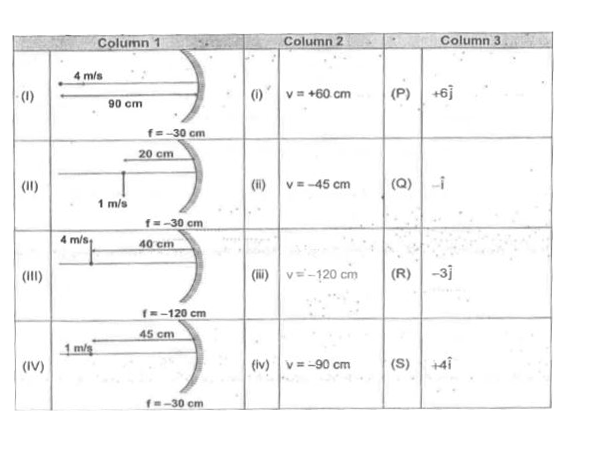
View Solution
Knowledge Check
Directions for Questions 56 and 57: In each question, there is a table having 3 columns and 4 rows. Based on the table, there are 3 questions. Each question has 4 options (a), (b), (c) and (d), ONLY ONE of these four options is correct.
Two charges of opposite sign and equal magnitude Q = 2.0 C are held 2.0 m apart. And there is a point Pat 4.0 cm from +Q charge. In the given table there are four values each of electric field (Column I), potential difference each of electric field (Column I), potential difference
{:("Column I","Column II", "Column III"),((I) E=1.27 xx 10^(9) V//m,(i) V=1.5 xx 10^(9) V,(J) (##MST_AG_JEE_MA_PHY_V02_C24_E03_059_Q01.png" width="80%">
The combination for maximum electric field isA(I) (ii) (M)B(III) (iv) (K)C(IV) (iii) (J)D(II) (i) (L)Directions for Questions 56 and 57: In each question, there is a table having 3 columns and 4 rows. Based on the table, there are 3 questions. Each question has 4 options (a), (b), (c) and (d), ONLY ONE of these four options is correct.
Two charges of opposite sign and equal magnitude Q = 2.0 C are held 2.0 m apart. And there is a point Pat 4.0 cm from +Q charge. In the given table there are four values each of electric field (Column I), potential difference each of electric field (Column I), potential difference
{:("Column I","Column II", "Column III"),((I) E=1.27 xx 10^(9) V//m,(i) V=1.5 xx 10^(9) V,(J) (##MST_AG_JEE_MA_PHY_V02_C24_E03_060_Q01.png" width="80%">
The combination for maximum electric potential isA(I) (ii) (M)B(III) (iv) (K)C(IV) (iii) (J)D(II) (i) (L)The following table has 3 columns and 4 rows. Based on table there are THREE questions. Each question has FOUR options (A) , (B) , ( C) and (D) . ONLY ONE of these four options is correct
 A(III) (iv) ( R)B(I) (ii) (Q)C(IV) (iii) (R )D(I) (iv) (Q)
A(III) (iv) ( R)B(I) (ii) (Q)C(IV) (iii) (R )D(I) (iv) (Q)
The following tables has 3 columns and 4 rows. Based on each table, there are THREE questions. Each question has FOUR options (A), (B), (C), and (D). ONLY ONE of these four options is correct
Q

View SolutionIn each question, there is a table having 3 columns and 4 rows. Based on the table, there are 3 questions. Each question has 4 options (a), (b), ( c) and (d), ONLY ONE of these four options is correct.
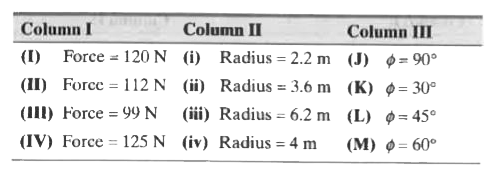
Which object has 137.5N⋅m as the resulting torque (as a vector)?
View SolutionIn each question, there is a table having 3 columns and 4 rows. Based on the table, there are 3 questions. Each question has 4 options (a), (b), ( c ) and (d), ONLY ONE of these four options in correct.
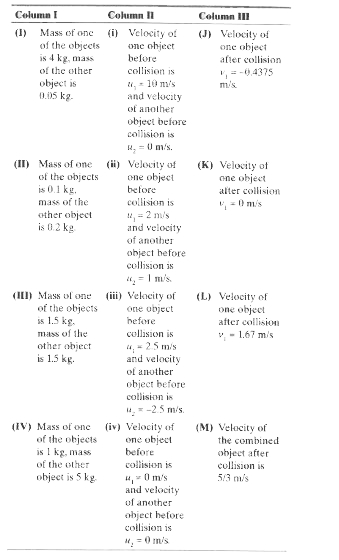
In which condition is the total momentum after collision 10 kg m/s ?
View SolutionIn each question, there is a table having 3 columns and 4 rows. Based on the table, there are 3 questions. Each question has 4 options (a), (b), ( c) and (d), ONLY ONE of these four options is correct.
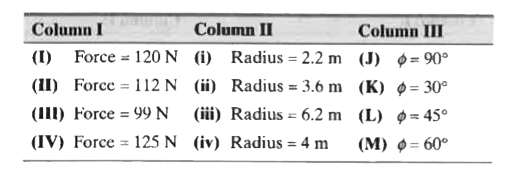
Which object has 178.2√3N⋅m as the resulting torque (as a vector)?
View SolutionThere is a table having 3 columns and 4 rows . Based on the table , there 3 questions . Question has 4 options (a) , (b) , (c) and (d) , Only one of the four options is correct .
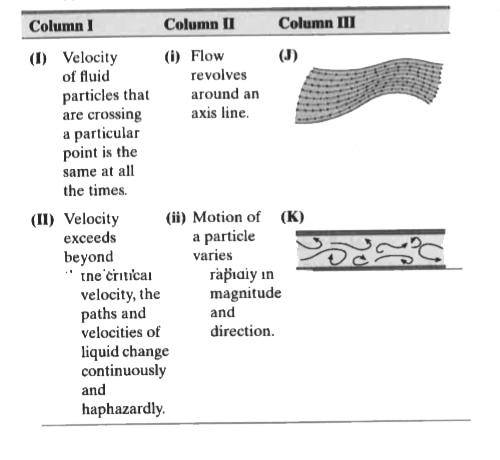
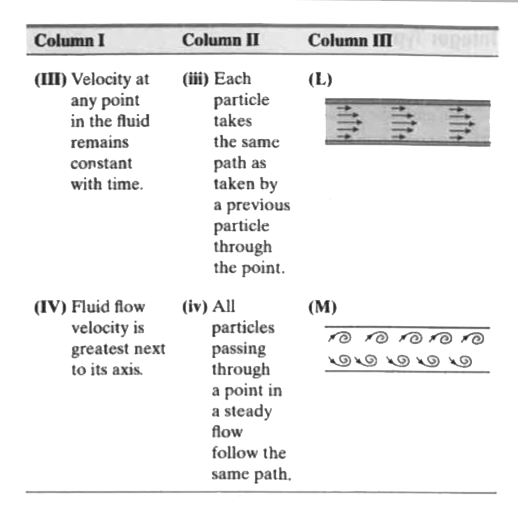
What are the characteristics of steady flow ?
View Solution

